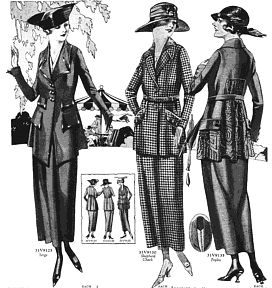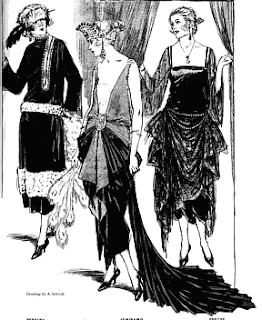"1920's Automobiles." The 1920's - Roaring Twenties - The Nineteen Twenties in History - Automobiles. Web. 14 Apr. 2011. <http://www.1920-30.com/automobiles>.
"1920's Womens Fashions - Dresses, Hair, Underwear and More." The 1920's - Roaring Twenties - The Nineteen Twenties in History. Web. 14 Apr. 2011. <http://www.1920-30.com/fashion/>.
"BBC - Homes - Design - 1920s." BBC - Homepage. Web. 14 Apr. 2011. <http://www.bbc.co.uk/homes/design/period_1920s.shtml>.
"CR20: The 1920's." Chicago: The Roarin' 20's Home Page. Web. 14 Apr. 2011. <http://chicagotheroarin20s.tripod.com/the1920s.html>.
Craven., Wayne. "American Cultural History - Decade 1920-1929." LSC-Kingwood Library. Web. 14 Apr. 2011. <http://kclibrary.lonestar.edu/decade20.html>.
Drowne, Kathleen Morgan., and Patrick Huber. The 1920s. Westport, CT: Greenwood, 2004. Print.
Harrison, Sharon, and Mark Weder. "Technological Change and the Roaring Twenties: A Neoclassical Perspective." Journal of Macroeconomics 31.3 (2009): 363-75. Print.
The Jazz Age: the 20s. Alexandria, VA: Time-Life, 1998. Print.
Locksley, Richard M. "The Roaring Twenties." Immunity 28.4 (2008): 437-39. Print.
Rosenberg, Jennifer. "Flappers in the Roaring Twenties." 20th Century History. Web. 14 Apr. 2011. <http://history1900s.about.com/od/1920s/a/flappers.htm>.
Streissguth, Thomas. The Roaring Twenties. New York, NY: Facts On File, 2007. Print.
Roaring Twenties Production Design Package
Thursday 14 April 2011
Production Design
Set Design
With the 1920’s, came an architectural revolution. Skyscrapers were beginning to pop up in major cities functioning as hotels and business offices. New materials and building methods were being invented. Houses were built to be heated and cooled more efficiently, they were easier to be kept clean and they were more suited to the lifestyles that the 1920’s demanded. They now housed mostly nuclear families without servants or maids.
Interior Set
The Roaring Twenties sparked the beginning of artistic and creative interior designs. The art deco movement influenced glamorous and sophisticated designs with many geometric and angular shapes. Chrome, glass shiny fabrics and mirrors were used throughout the houses. Stylized images of airplanes, cars, cruise ships, skyscrapers were incorporated into the décor. Now that travel was quite common, other cultures were being incorporated into style through exotic touches from Asia, Africa and Egypt.
Interior Colour Palette: Silver, black chrome, black and white, red, green
Props
In the 1920’s, mass production and assembly lines made technology affordable to all classes. Purchases of movies, cars, radios and medicine skyrocketed. One of the greatest technological advances in sound recording, electrical recording, became available to the public through phonograph records.
Exterior Set
The streets of Chicago were changing. With the popularity of owning automobiles growing rapidly, street signs and traffic lights were beginning to be installed. With the assembly plant making cars more affordable and faster to make, Ford was able to now invest money into making the automobile more stylistic. Cars were now being painted vibrant colours and both interiors and exteriors were being designed to be just as stylish as the people who drove them.
Car Colour Palette: Red, blue, white, black
Hair and Makeup
Hair
To compliment the desired boyish figures, came a hairstyle called the Bob. Originally, women in ambulatory care, nursing and the military cut their hair short and straight above the neck for practical purposes. It was sanitary and out of the way. The haircut made women look youthful and was happily adopted by the fashion world after the First World War.
On top of their newly styled hair, women often chose to place a hat. For casual or semi-formal and even formal events, a bell-shaped felt hat, called a cloche, was all the rage.
Makeup
As a finishing touch, makeup became a norm for women to wear. It was no longer just for prostitutes or very loose women. Ivory coloured face powder was in fashion with a noticeable amount of rouge blush powdered on their cheeks. In the latter half of the decade, orange blush started phasing itself into popularity. Lipstick was often the most dominant cosmetic applied to women’s faces. Very deep colours, often dark shades of red, were painted on the lips in a “Cupids-bow” fashion, making the lips appear thinner. Eyes were also held quite dark. Women outlined their entire eye with black eyeliner and blurred the edges. Different shades of grey eye shadow were often used, occasionally accented with green or turquoise shades depending on what she chose to wear. Mascara was also applied quite thickly. Fingernails were painted only in the centre of the nail in a half-moon shape. The top and bottom of the nail were left bare.
 |
| "Cupids Bow" |
Makeup Colour Palette:
Costume Design
Women’s Wardrobe
Women certainly stood out in this wild and stylish era. On August 18, 1920, the Nineteenth Amendment was passed granting women the right to vote. It was the most critical moment in the women’s rights movement. This liberation sparked many other changes in women’s lifestyle. They now flaunted their sexuality freely.
Check out the wonderful women of the 20's!
Check out the wonderful women of the 20's!
Women's clothing had to adapt for practical reasons in order to fit their new lifestyle. With dancing to jazz music every night, came shorter and looser dresses in order to enable the women to swing and dance without restriction. Aside from their parents, no longer was there societal pressure to be conservative with their clothing. They expressed themselves through vibrant coloured silk stockings and dresses that ended just short enough to reveal their knees when they danced. Throughout the decade, corsets became increasingly smaller to allow the women to have more movement in their torso. They eventually became so small that they turned into the modern-day bra.
Contrary to this innovation, the invention of the Symington Side Lacer was introduced. Because the young-boyish look was considered popular and desirable in a woman, women with large busts chose to wear the Symington Side Lacer that had tightening lace on the side, which flattened a woman’s breasts.
 |
| Symington Side Lacer |
 | |
| Late 20's Bra |
This modern woman was called a Flapper.
Templates for 1920's flapper costumes:
 |
| Flappers from 1924-1925 |
 |
| Flappers from 1926-1927 |
 |
| Flappers from 1928-1929 |
Women's Wardrobe Colour Palette:
Men’s Wardrobe
With women’s fashion having been completely redefined, men had to shape up too! No longer were they conservative with their fashion either. Suits became more extravagant yet relaxed. Instead of switching from one stiff, heavy suit to another depending on what time of day it was like they did previous to World War One, they developed a lighter, looser suit (often plaid or tweed) that was acceptable to wear all day long.
Long jackets were only required during formal events allowing men to wear jackets that ended at the hip, which influenced more aesthetic belts to be designed because they were now seen. Due to influence from the wartime uniforms, buttons on the jackets did up much higher. Lapels were thinner and every man’s pocket was filled with a handkerchief. Fat, patterned ties tied the suit together with multiple colours.
Trousers were straight, narrow and short, which allowed more movement during dancing. Because socks were now seen, men became more expressive by choosing bright colours to flash when they performed dance moves that revealed their socks.
Shoes became more colourful and often involved two-tones and fringed tongues. They were lighter weight and more flexible to ensure swift dance moves could be executed.
Hats became all the rage. Trilbies, bowlers, boaters and caps were all used throughout the different times of year and social classes. In the winter, the fedora, trilby and boater were the most popular.
Men's Wardrobe templates:
Men's Wardrobe Colour Palette:
Subscribe to:
Posts (Atom)

















































